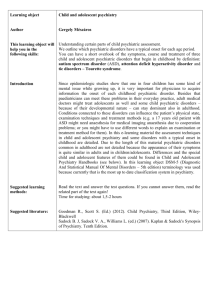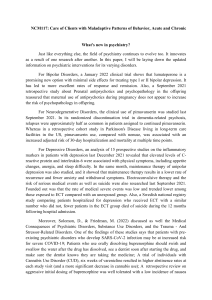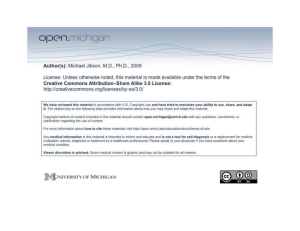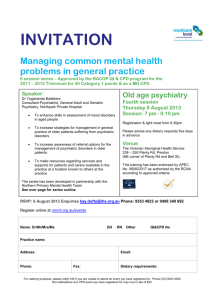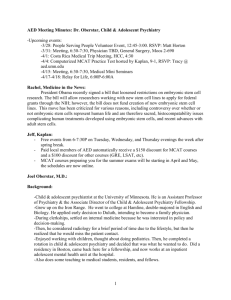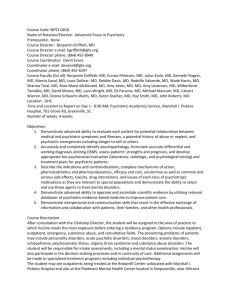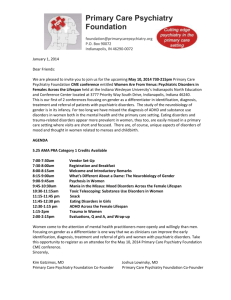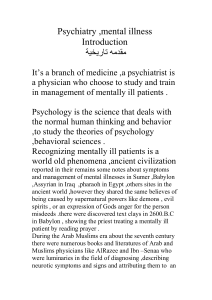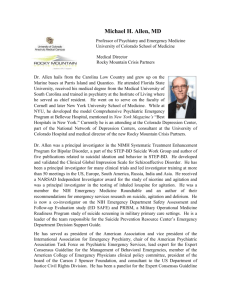Diversity in Medicine: Psychiatry and Mental Health
advertisement
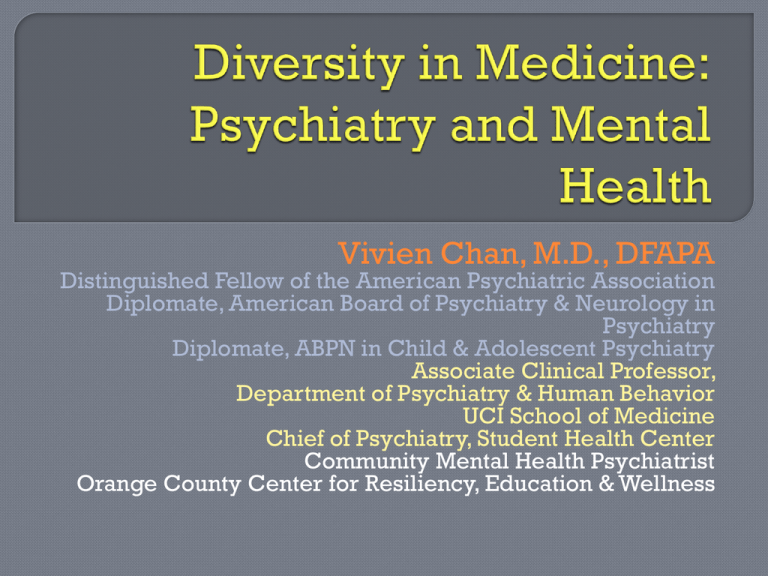
Vivien Chan, M.D., DFAPA Distinguished Fellow of the American Psychiatric Association Diplomate, American Board of Psychiatry & Neurology in Psychiatry Diplomate, ABPN in Child & Adolescent Psychiatry Associate Clinical Professor, Department of Psychiatry & Human Behavior UCI School of Medicine Chief of Psychiatry, Student Health Center Community Mental Health Psychiatrist Orange County Center for Resiliency, Education & Wellness Psychiatry: Scope of Practice Socioeconomic Diversity of Mental Disorders Emerging Adulthood: Issues in Colleges and Universities Medical Specialty (M.D. or D.O.) with + 4 years of post-graduate training • Medical treatment + Talk (Psychotherapy) and Other Therapies Up to 1 – 4 additional years of subspecialty training (fellowships) • Child & Adolescent; Geriatric, Forensic (legal), Psychosomatic, Addiction, Sleep and more . . . Board Certification by the American Board of Psychiatry & Neurology Meet Curtis Adams, M.D., a community / public-health psychiatrist in Maryland • Real Psychiatry: Doctors in Action a production of the American Psychiatric Association Department of Minority and National Affairs Video (9:28) 20% of all adults in the U.S. had a mental illness in the past year (2010 SAMHSA) • ~ 45.9 million Americans, or 1:4 • 4 - 6% suffer from a serious mental illness (SMI) 1:17 There are about 40,000 psychiatrists practicing in the United States There are 4,800 Child & Adolescent Psychiatrists in the United States Last Census Data: US – 313.9 Million About 45,000 more psychiatrists needed Definition / Criteria of Serious Mental Illness • Mental, Behavioral or Emotional Disorder • Did not include substance abuse or developmental disorders (e.g. autistic disorder) • Diagnosed with in the past year • Met criteria found in DSM-IV TR • Resulted in serious functional impairment which substantially interferes with or limits one or more major life activities Developmental and Learning Disorders • E.g. Autistic Disorder, ADHD, Intellectual Disability) Mood Disorders (e.g. Major Depression, Bipolar) Anxiety Disorders (e.g. Panic, Phobia) Trauma (e.g. PTSD) Thought Disorders (e.g. Schizophrenia, Psychosis) Delirium and Dementia Impulse Control Disorders Substance Use Disorders Often work in a multidisciplinary team Physician Assistants (PAs) Advance Practice Nurses / Nurse Practitioners; Registered Nurses (APRNs) Medical Assistants / Psychiatric Technicians Psychologists (Ph.D. or Psy.D.) Social Workers (LCSW, MSW) Therapists (MFT, LPCC) “Counselors” (usually, drug & alcohol) Wellness educators Patient Advocates Public or Community Mental Health • MediCare or MediCaid (Medi-Cal) • Indigent • Uninsured Insurance-Based Private / 3rd Party Payor (out-of-pocket, outside the insurance system, self-pay) Supplemental Security Income (SSI) • Disabled Adults and Children with Limited Income and Resources • $1 – 721 / month per individual + the ability to earn $1070 / month in substantial gainful activity Social Security Disability Insurance (SSDI) • No income eligibility capitation • MUST have previously “paid into” the system by earning S.S. work credits (~ 5 yrs full time work) The “other” 42% 75% of incident cases occur by age 25 years (National Comorbidity Study, 2005) Major Depression is the Leading Cause of Disability Suicide is the 2nd leading cause of death in college and university students (behind accidents) A population often seen as privileged Stressors often misunderstood • “all they have to do is go to school” Social Norms: drinking, partying Facts: • Multiple stressors and pressures • Living, financial, relational + expectations • Graduate school carries higher vulnerability Access in a Fragmented System • Public or Community Mental Health • Insurance-Based, 3rd Party Payor • Private, out-of-pocket self-expense Most managed-care systems encourage other specialty visits within 15 days In the U.K., a goal benchmark is to get a child/adolescent psychiatric consultation within 26 weeks (i.e. 6 months) Suicide is Preventable The Truth about Suicide: Real Stories of Depression in College • The American Foundation for Suicide Prevention • Video (26:00) Using Sensitive Language • Death by Suicide / Death By Suicide Attempt • NOT “successful,” “gesture,” “suicided,” or “committed” • Controversial: using complete / incomplete or “aborted” Overcoming Class Stigma Choice • Last Video: “Conversations” Brook Shields (2007) Lorraine Bracco (2011) • Or AFSP Video End: Week 10 Winter Quarter 2014
